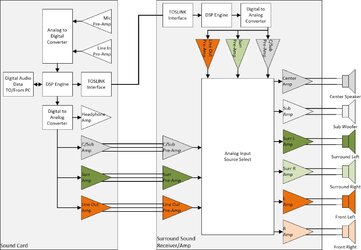- Joined
- Sep 25, 2015
For the past while, I've been running sound out of my PC using the motherboard TOSLINK optical connector to run to an old surround system I have.
Recently while flying my spaceship in Elite Dangerous, I was beginning to think that my 20 year old surround system was starting to die as I wasn't hearing separated/crisp audio from the surround speakers.
While poking around the internet, I found that other people had a similar issue. We had 1 thing in common...a Realtek audio controller on our motherboards.
When I first setup the system, I used various movies to test the surround. The appropriate DTS/Dolby Digital LEDs lit while playing the movie, so I "knew" things were working fine.
On a whim, I did some Google searching and found this website: https://www2.iis.fraunhofer.de/AAC/multichannel.html
When I ran the test signals, I was not getting separate audio from my rear channels...just like I thought was going on in-game.
I played a movie, and it worked fine. So the 20 year old surround system (Kenwood) is still working great.
I was REAL close to getting a new sound card. Again, on another whim, I went out and bought 3 sets of 3.5 mm to RCA cable sets, and plugged the analog audio from my motherboard into the surround analog inputs on the surround system.
WOW...I now have full surround on my system...even in games!
What a difference!
After more research, it appears as though the motherboard manufacturers did not want to pay the Dolby license fee to encode non-movie data into the compressed digital optical format.
This is not true for all motherboards.
If you are not sure, run the test files from the website above...it will tell you for sure.
Now...it's like I'm gaming on a whole new level...I had NO IDEA what I was missing!

Recently while flying my spaceship in Elite Dangerous, I was beginning to think that my 20 year old surround system was starting to die as I wasn't hearing separated/crisp audio from the surround speakers.
While poking around the internet, I found that other people had a similar issue. We had 1 thing in common...a Realtek audio controller on our motherboards.
When I first setup the system, I used various movies to test the surround. The appropriate DTS/Dolby Digital LEDs lit while playing the movie, so I "knew" things were working fine.
On a whim, I did some Google searching and found this website: https://www2.iis.fraunhofer.de/AAC/multichannel.html
When I ran the test signals, I was not getting separate audio from my rear channels...just like I thought was going on in-game.
I played a movie, and it worked fine. So the 20 year old surround system (Kenwood) is still working great.
I was REAL close to getting a new sound card. Again, on another whim, I went out and bought 3 sets of 3.5 mm to RCA cable sets, and plugged the analog audio from my motherboard into the surround analog inputs on the surround system.
WOW...I now have full surround on my system...even in games!
What a difference!
After more research, it appears as though the motherboard manufacturers did not want to pay the Dolby license fee to encode non-movie data into the compressed digital optical format.
This is not true for all motherboards.
If you are not sure, run the test files from the website above...it will tell you for sure.
Now...it's like I'm gaming on a whole new level...I had NO IDEA what I was missing!


